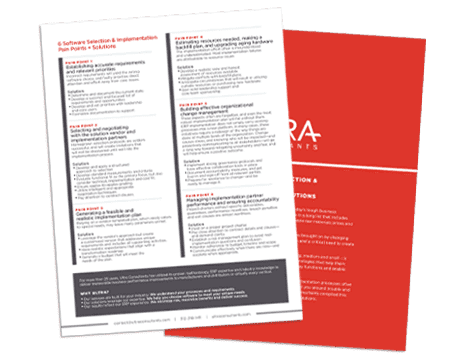Many of the complex manufacturing organizations we speak with face business challenges when looking to simplify the production of engineered, ordered, planned and controlled products that are configured or assembled uniquely for each customer order.

It’s an important set of challenges to consider when looking at business process improvement. And it’s a business issue quite familiar to complex manufacturing organizations.
We’ve looked at the issue of enterprise technology systems for complex manufacturing in previous blog posts – looking at the technology platforms needed to help streamline complex configurations.
A recent post examined the right time to consider product configurator software for manufacturing complex products.
The focus of this blog post is what to consider when looking at integrating product configurator and ERP systems.
Looking at the Product Configurator and ERP
Any discussion of integrating the product configurator and ERP first has to consider the types of organizations challenged by these processes. Thus, a few definitions are in order:
- Engineer to Order or ETO: An ETO organization produces complex, custom products that must meet customer specifications. Products built once an order is received.
- Made or Make to Order or MTO: These organizations manufacture standard products which are not held in inventory, but only built when a committed order is issued by the customer. With MTO environments, standard variations can be used.
- Configured to Order or CTO: With CTO processes, the standard product is designed to order. However, the product is not so differentiated from the standard.
Typically, these process environments are interested in looking at integrating the product configurator and ERP to help with questions such as:
- How difficult it is to manage complex configurations to reduce costs and errors.
- Improving processes to respond to fast changes in customer requirements, and improve the ability to deliver on time.
- How the existing ERP software helps scale production up or down quickly as the demand changes in real time.
- How well is the company managing parts and sub-assemblies and what improvements would be needed?
Additional Challenges
As an independent ERP consulting firm, the issue around product configuration is a topic that comes up often as project teams look to Ultra to understand the best way to work through enterprise system selection to improve key processes.
To break the challenges down even further, it’s common for organizations to grapple with the following:
- The need to satisfy the customer with a customer-specific version of the product
- Personalization is required by the customer
- Shorter lead times demanded by the customer
- Excessive data management to cover all possible combinations of options
- Order Entry lead time needs to be reduced
- Engineering lead time needs to be reduced
- Engineering resources are limited and expensive
- Errors in order processing and data management once the configuration is understood
- Inability to forecast and plan at the configured, end item level
- Product development cost control
- Communication between departments in the organization so that all the customer requirements are properly translated to the production of the product
- E-Commerce – the need to allow self-service ordering by the customer
- Engineering knowledge needs to be retained as knowledgeable people leave the workforce
- A strong need for Product Lifecycle Management (PLM)
- A constantly changing product where the possible configuration changes
In Search of Flexibility
Given the preceding outline of the challenges common to complex manufacturers, it’s clear handling configuration the same old way isn’t going to keep project teams competitive. That’s where integrating the product configurator and ERP comes into play.
As part of ERP process improvement services, it’s important for complex manufacturers to look at the current state of how they handle product configuration, with an eye toward increased flexibility and better managing the proliferation of items, bills, and routings for uniquely configured products.
Improving the Product Configurator process makes it easy for customers and distributors to buy products. Product Configuration allows both sales and customers to select, configure, price, and order products, while simultaneously making sure that only valid features, options, and dimensions are selected.
An automated Product Configurator solution, especially when integrated with ERP, can drastically reduce order lead times and engineering costs by allowing engineering to focus on orders falling outside the rules and on new product development.
Thinking Product Configurator and ERP? Learn More
We’ll be looking deeper at product configuration in upcoming blog posts. As you consider your own set of requirements when it comes to the product configurator and ERP, see the following resources
As independent consultants serving manufacturers and distributors, we’ve seen that outdated processes about the product configurator and ERP hinders business process improvements.
To help assess steps to improve, take a moment to explore these informative resources.
- ERP Health Check Survey: Take a survey to see if your company is being held back by an out-of-date legacy process related to product configuration.
- On Demand Webinar: View an on demand webinar to help you assess the maturity and health of your system.
- ERP Maturity White Paper: For even more detail, download the paper “ERP Maturity and Health: Is Your Business at Risk with Your Legacy System?”
Concerned about the health of your product configurator and ERP process? Contact Ultra for the best way to go forward.
6 Software Selection & Implementation Pain Points + Solutions
Software selection and implementation processes often present challenges of their own. To steer you around trouble and help you drive success, Ultra’s experts compiled a list of pain points and solutions to be aware of as you embark on this journey.

Table of Contents
More ERP material...
AI in Food and Beverage Manufacturing
Discover how AI is revolutionizing food and beverage manufacturing, enhancing quality, reducing…
How ERP for Quality Control Eliminates Manual Documentation Chaos
This post will examine why managing quality records outside of an ERP…
Assessing Your AI Maturity
This article breaks down how businesses can measure their AI maturity to…



